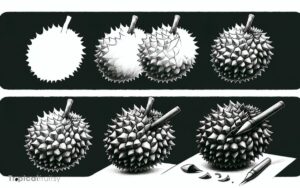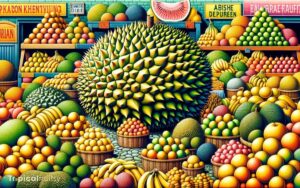What Does Durian Taste Like? Explained!
Durian is a fruit with a complex taste that combines sweet, savory, and creamy elements, often compared to a rich almond-flavored custard with notes of garlic and caramel. Its strong aroma and custard-like texture make it a polarizing delicacy.
Durian’s taste is multifaceted, with an initial sweetness akin to tropical fruits, followed by more intricate flavors. It has a custard-like consistency and a powerful smell that is notorious for being overwhelming.
The fruit’s versatility is celebrated in Southeast Asian dishes, despite its divisive nature.
Experiencing durian is a sensory journey—its complex taste and pungent aroma make it a unique fruit adventure.
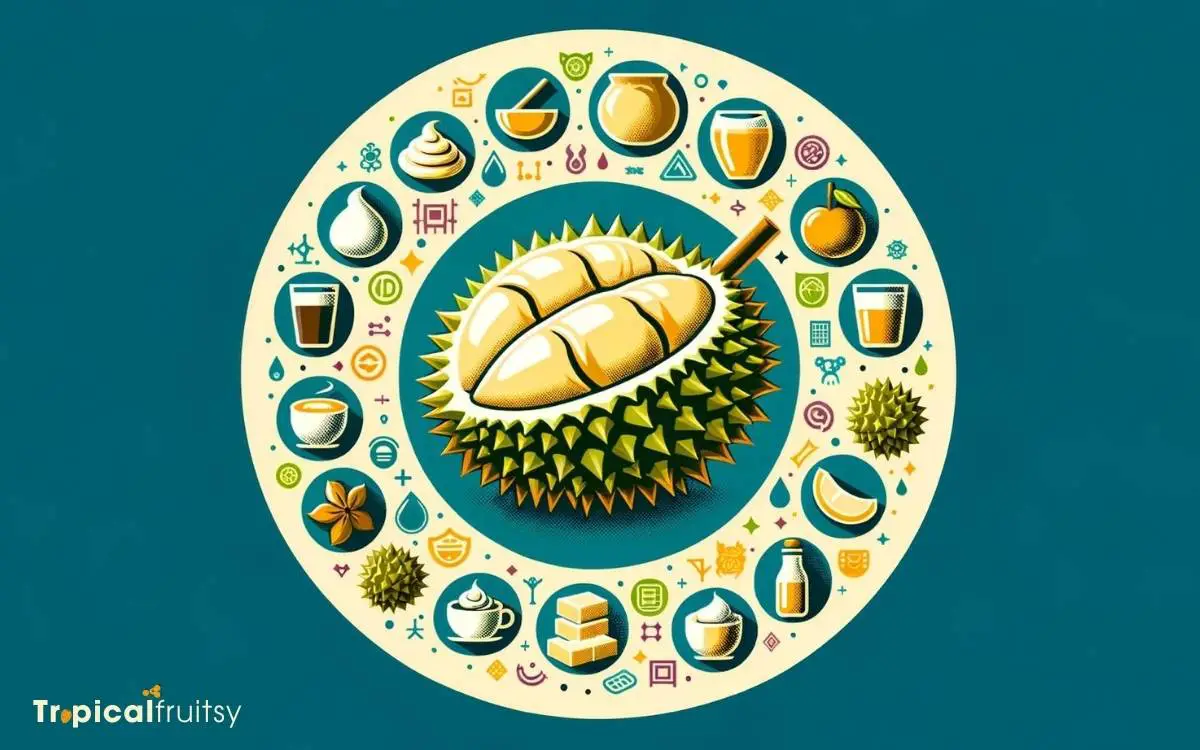
Key Takeaway
Exploring the Unique Taste Profile of Durian
| Aspect | Description |
|---|---|
| Initial Taste | Sweet, reminiscent of tropical fruits |
| Secondary Flavors | Almond, garlic, caramel |
| Texture | Creamy, custard-like, melts in the mouth |
| Aroma | Strong, pungent, infamously overwhelming |
| Culinary Use | Versatile in desserts and savory dishes in Southeast Asia |
Unveiling the Durian Fruit

Beneath its formidable spiky exterior, the durian fruit conceals a uniquely flavored flesh that elicits strong reactions from within the culinary world.
This tropical fruit, revered in Southeast Asia as the ‘king of fruits,’ possesses a complex taste profile that defies simple description.
Its rich, custard-like texture is interwoven with hints of almond, but these sweet and creamy notes are juxtaposed with a pungent aroma often likened to onions or ripe cheese.
Analytically, durian’s flavor is a symphony of sweet and savory, a culinary paradox that intrigues the palate.
The evocative experience of tasting durian is as much about its distinctive smell as its multifaceted flavor, making it a fruit that demands a nuanced understanding and an adventurous spirit to appreciate fully.
The Aroma Experience

The durian’s scent, a potent compound of sulfurous and fruity notes, is often the first encounter one has with this enigmatic fruit, shaping its notorious reputation among uninitiated consumers.
Its aroma is complex, evoking reactions that range from deep appreciation to intense aversion.
Analytically, the smell is an intricate tapestry woven from volatile organic compounds that prompt comparisons to everything from ripe cheese to caramelized onions.
Those with a discerning nose may detect a sweet undercurrent, reminiscent of overripe tropical fruits, beneath the dominant olfactory overture of pungency.
This unique fragrance profile is not merely passive; it asserts itself, filling the space, challenging and intriguing the senses. It sets the stage for the taste exploration to follow, underscoring the axiom that first impressions matter.
First Impressions Matter

Engaging with the durian fruit for the first time, one’s initial encounter with its taste is as memorable as the distinctive aroma suggests.
The creamy texture surprises many, offering a custard-like consistency that contradicts the spiky exterior of the fruit.
Upon the palate, a complex blend unfolds, rich with sweet, almond-like flavors interspersed with savory notes, often compared to cheese or onion.
This melange of tastes, combined with an olfactory sensation that ranges from intensely fragrant to pungently off-putting, ensures the durian leaves a lasting first impression.
The experience is polarizing; some find the combination enchanting, an exotic delicacy, while others recoil from the initial shock, their taste buds overwhelmed by durian’s assertive profile.
Every reaction, however, underscores the fruit’s unique and unforgettable character.
Sweetness and Texture Explored
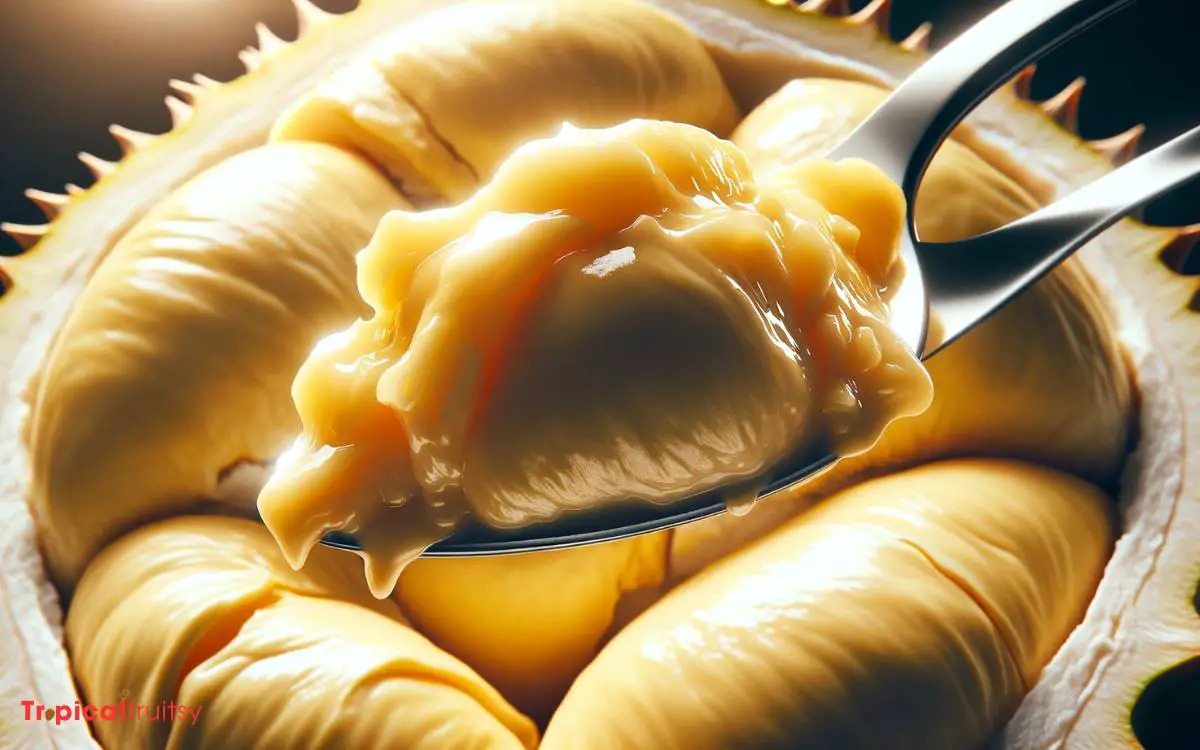
The durian’s sweetness, often likened to a rich alchemy of sugar-drenched fruit, varies significantly across different cultivars, each offering a unique tapestry of taste.
Beneath its spiky armor lies a texture reminiscent of creamy custard, a luscious contradiction to the fruit’s formidable exterior.
The degree of ripeness plays a crucial role, as it amplifies the inherent sweetness and can transform the flesh from firm to a melt-in-the-mouth indulgence.
Flavor Profile Variations
Durian’s flavor profile encompasses a vast spectrum of sweetness and a unique array of textures that vary significantly among different cultivars and stages of ripeness.
The luscious fruit is notorious for its assertive taste, often described as a blend of savory, sweet, and creamy notes.
The texture can range from custard-like and buttery to fibrous and firm, depending on the variety and its maturity when consumed.
| Cultivar | Sweetness/Texture Characteristics |
|---|---|
| Monthong | Mildly sweet, creamy, and smooth |
| Chanee | Intense sweetness, firmer texture |
| Musang King | Rich and complex, custard-like |
| Red Prawn | Sweet with a hint of bitterness, soft |
| Green Cat | Milder taste, more fibrous texture |
Each type presents a mosaic of flavors and mouthfeels, inviting an adventurous palate to discern the subtleties that make durian a fruit like no other.
Creamy Custard Consistency
Although often polarizing due to its pungent aroma, durian’s texture is frequently likened to a rich, creamy custard, with a sweetness that envelops the palate in a complex symphony of flavors.
This custard-like consistency is not just a simple, one-dimensional creaminess; it is a velvety, smooth experience that defies expectations. The flesh yields under slight pressure, indicating its lushness and the readiness of its consumption.
Upon tasting, the durian reveals a sweetness that is nuanced, with waves of sugary intensity that can verge on caramel-like richness or a gentler, more subdued honeyed essence.
This textural and flavorful depth provides an indulgent experience, challenging and rewarding the senses simultaneously.
Durian’s sensory profile is a testament to its status as the ‘king of fruits,’ offering a unique culinary journey.
Ripeness Impacting Sweetness
Assessing the influence of ripeness on durian, one finds that the fruit’s sweetness intensifies and its texture softens as it matures.
The ripening process catalyzes a transformation within the durian’s flesh, coaxing out a sugary richness that is enigmatically woven into its complex flavor profile.
As the durian progresses from a young, firm state to a fully ripened delicacy, the flesh succumbs to a creamy decadence, reminiscent of a velvety custard.
This textural metamorphosis is accompanied by an amplification of the fruit’s inherent sweetness, creating an indulgent experience that belies its thorny exterior.
Each stage of ripeness invites a deeper exploration into the symphony of flavors durian offers, seamlessly bridging into the next sensory experience: the savory notes unpacked.
Savory Notes Unpacked
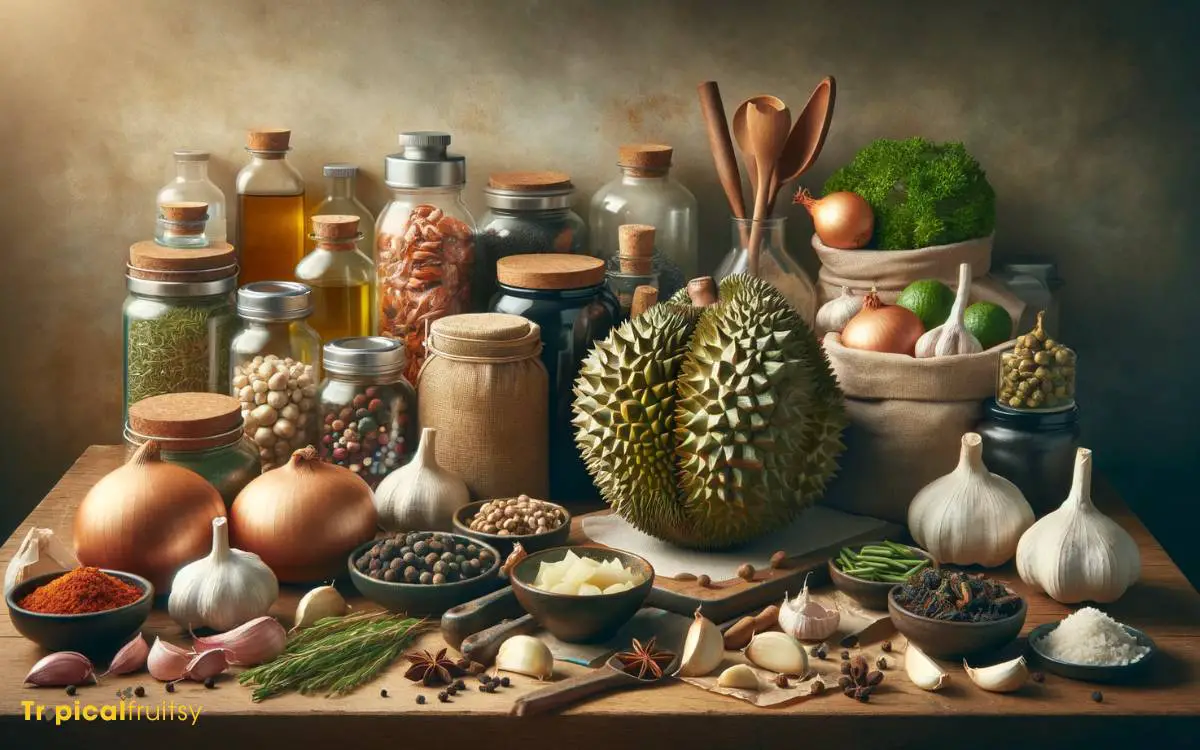
Complexity characterizes the savory aspect of durian flavor, often surprising the palate with a rich amalgamation of umami undertones.
- Hints of caramelized onions: This comparison draws attention to the unexpected savory sweetness inherent in durian.
- Roasted almond nuances: A nutty, toasted depth parallels the fruit’s more pronounced savory profiles.
- Aged cheese parallels: For those with a discerning palate, the creamy fermentation notes may recall certain matured cheeses.
This multifaceted savoriness weaves through the durian’s profile, lending an enigmatic depth that defies simple categorization.
It’s a symphony where each savory note contributes to the overall gastronomic intrigue, exciting food enthusiasts and the culinarily curious alike.
Creaminess and Consistency

Exploring the durian’s texture reveals a velvety creaminess that contrasts with its pungent aroma, providing a unique mouthfeel that is both custard-like and somewhat sticky.
This luscious consistency is a hallmark of the fruit, often surprising first-time tasters with its rich, buttery nature that coats the palate.
The flesh of the durian, encased within its formidable spiky husk, yields to pressure with a yielding softness, akin to a ripe avocado or a well-set panna cotta.
An analytical probe into this textural experience would classify it as a complex interplay of melt-in-the-mouth decadence with a tactile cling that lingers after each bite, inviting contemplation of its multifaceted nature.
This indulgent creaminess sets the stage for an intriguing comparison with other fruits, guiding us to the next section of our sensory journey.
Comparisons With Other Fruits
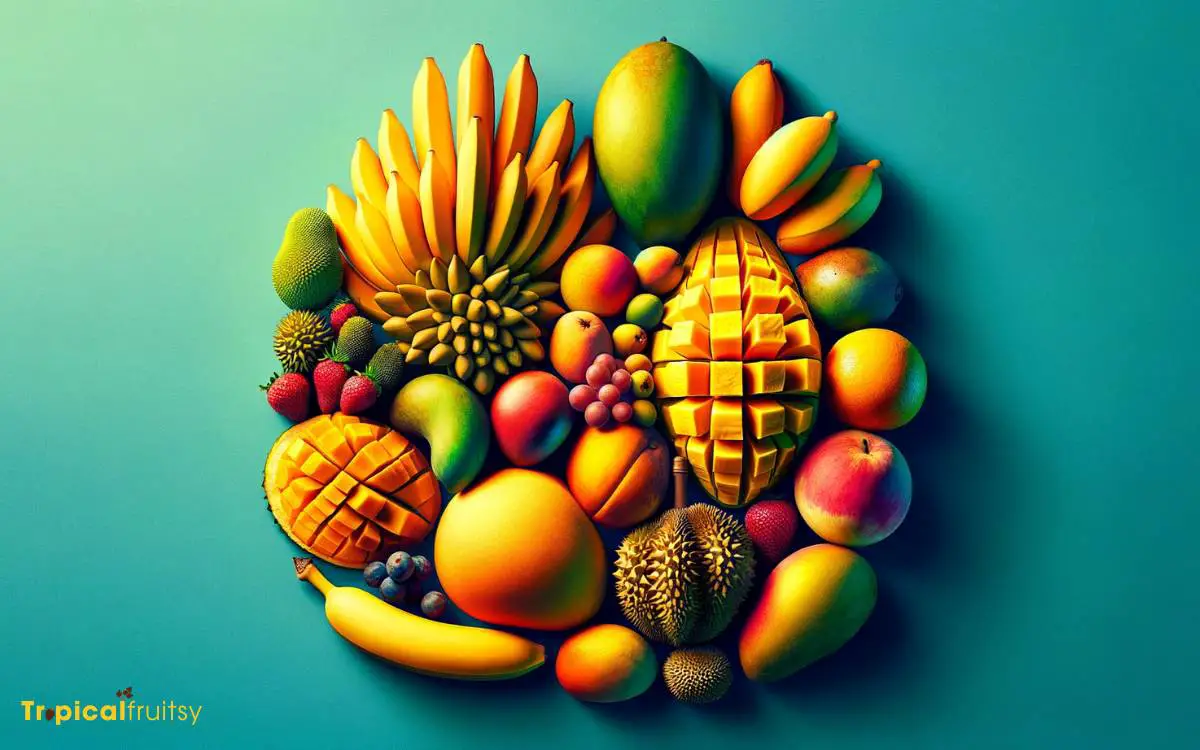
To comprehend the unique flavor profile of durian, one must consider its gustatory kinship with other exotic fruits.
While its taste hints at the sweetness found in mangoes and the savoriness reminiscent of ripe bananas, durian’s custard-like texture stands in stark contrast to the fibrousness of a mango or the smoothness of a banana.
This juxtaposition of familiar flavors with an unparalleled texture invites both intrigue and trepidation from first-time tasters.
Flavor Profile Similarities
Durian’s unique flavor profile bears resemblances to certain tropical fruits, such as jackfruit, banana, and mango, when considering its sweet and creamy characteristics.
This exotic fruit’s taste is a symphony of flavors that some find delightful and others overwhelming.
The durian is often compared to other fruits for its layered complexity:
- Jackfruit: It shares a similar fibrous texture and sweetness, yet durian’s consistency is creamier and its taste more intense.
- Banana: Durian’s custard-like flesh might remind one of ripe bananas, with its rich, sugary flavor profile.
- Mango: The luscious, tropical notes in durian can evoke the succulence of a perfectly ripe mango, but with a more pungent twist.
These comparisons, while helpful, cannot fully capture the durian’s multifaceted nature. Connoisseurs often emphasize the fruit’s unparalleled depth, with hints of almond and a savory complexity that defies simple categorization.
Texture Differences
While the taste of durian is often the focus, it’s the fruit’s distinctive texture that sets it apart from other tropical fruits, offering a creamy, custard-like consistency unlike the firmer flesh of jackfruit or the fibrous strands of mango.
When one delves into the fleshy depths of a durian, the experience is akin to indulging in a rich, silken mousse, each segment yielding to the slightest pressure.
In contrast, jackfruit presents a chewier, meaty texture, often compared to pulled pork when unripe. Mango, on the other hand, has a juicy, tender quality with a slight fibrousness that provides a satisfying chew.
Durian’s texture is a marvel in the fruit world, a velvety concoction that coats the palate, demanding attention and often, an acquired appreciation.
Acquired Taste Phenomenon

Regarding the acquired taste phenomenon, durian often requires multiple tastings before individuals appreciate its complex flavor profile.
This piquant fruit presents a gastronomic challenge, unfurling its sensory enigma only to the persistent palate. Its taste, a mélange of sweet, savory, and creamy, can initially disconcert the unacquainted taster.
- Sensory Shock: First-timers may be overwhelmed by the intensity of durian’s aroma and taste.
- Flavor Evolution: Repeated exposure can lead to a greater appreciation of the fruit’s nuanced flavors.
- Cultural Acclimatization: Embracing durian often involves understanding its significance in local food traditions.
This unique fruit’s allure lies within its complexity, inviting an odyssey of taste that evolves from initial skepticism to eventual delight.
Culinary Uses and Pairings
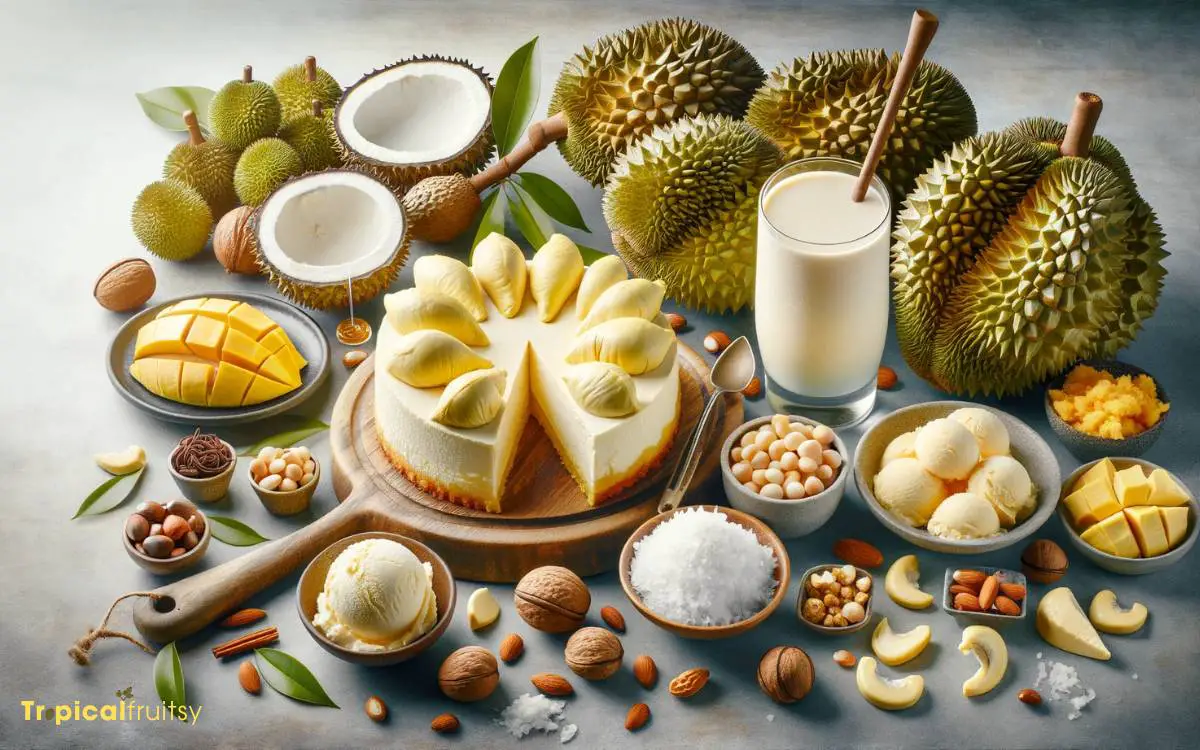
Numerous culinary applications highlight durian’s unique flavor profile, ranging from traditional desserts to contemporary fusion dishes.
Revered in Southeast Asia as the ‘king of fruits,’ durian imparts a custard-like texture and a complex taste, marrying sweetness with a savory depth, to a variety of gastronomic creations.
It is the soul of sinfully rich pastries, such as creamy durian puffs, and the centerpiece in sticky rice desserts draped in coconut milk.
Innovative chefs daringly pair it with unconventional counterparts, such as chocolate, to accentuate its multifaceted flavor. Moreover, durian’s potent essence transforms ice creams and milkshakes into exotic indulgences.
Analyzing its culinary versatility, one understands that durian’s pungency is not a hindrance but a beacon for creativity, elevating dishes with its distinctive character.
Conclusion
Durian’s unique taste profile, exhibiting a blend of sweet, savory, and creamy elements, polarizes many due to its potent aroma.
Beyond its immediate sensory impact, this fruit’s texture and complex flavor notes position it as a versatile culinary ingredient.
Despite initial aversion, some develop a palate for durian, indicative of its ‘acquired taste’ status.
Interestingly, over 65% of Southeast Asia’s population consume durian regularly, underscoring its cultural and gastronomic significance in the region.

